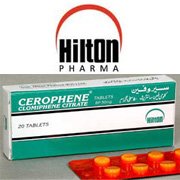
Conservative selection and management of the patient contribute to successful therapy of anovulation. Cerophene induces ovulation in most selected anovulatory patients. The various criteria for ovulation include an ovulation peak of estrogen excretion followed by a biphasic basal body temperature curve, urinary excretion of pregnanediol at post-ovulatory levels and endometrial histologic findings characteristic of the luteal phase.
Cerophene therapy appears to mediate ovulation through increased output of pituitary gonadotropins. These stimulate the maturation and endocrine activity of the ovarian-follicle which is followed by the development and function of the corpus luteum. Increased urinary excretion of gonadotropins and estrogen suggest involvement of the pituitary.
What Is Cerophene Used for?
Cerophene is indicated for the treatment of infertility due to impaired hypothalamic pituitary function. Cerophene stimulates the secretion of pituitary gonadotropic hormones probably by blocking the effect of estrogens at receptor sites in the hypothalamus and pituitary.
Cerophene is indicated for the treatment of anovulatory infertility in patients desiring pregnancy. Therapy with Cerophene will not be successful unless the woman, though anovulatory, is capable of ovulation and her partner is fertile. It is ineffective in primary pituitary or primary ovarian failure.
Administration of Cerophene is indicated only in patients with demonstrated ovulatory dysfunction and in whom the following conditions apply:
- Normal liver function.
- Physiological indications of normal endogenous estrogen (as estimated from vaginal smears, endome-biopsy, assay of urine or from bleeding in response to progesterone). Reduced estrogen levels while less favorable, do not prevent successful therapy.
- Cerophene therapy is not effective for those patients with primary pituitary or ovarian failure. It cannot substitute for appropriate therapy of other disturbances leading to ovulatory dysfunction, e.g. diseases of the thyroid or adrenals.
A careful evaluation prior to Cerophene therapy should be done in patients with abnormal uterine bleeding. It is most important that neoplastic lesions are detected.
Related Links
Leave A Comment